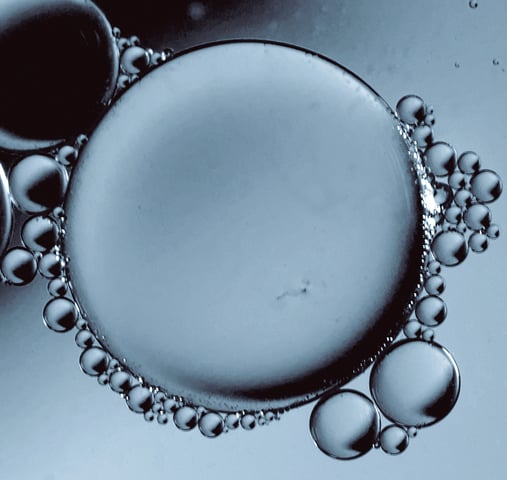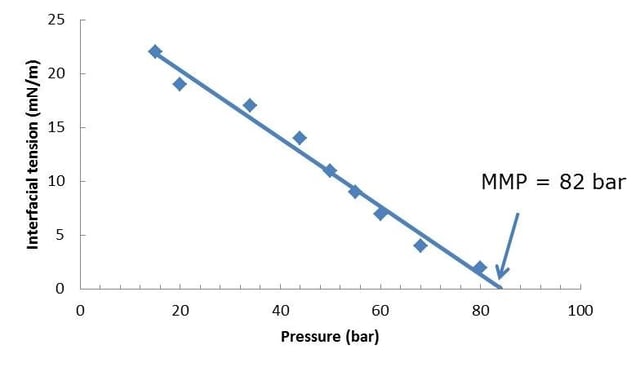
As the exploration of new oil reservoirs is slowing down, there is a need to be able to utilize the current oil reservoirs more efficiently. After primary and secondary recovery, at least 50% of the original oil is left behind in the reservoir [1]. Additional injections of fluids like polymers, surfactants or different gases are commonly used to displace and dissolve some of the remaining oil. This process is called tertiary or enhanced oil recovery (EOR) and can lead to an additional 8-16 % uptake of original oil in place (OOIP) [1].
Miscible gas injection has become a widely used technique in enhanced oil recovery. The main objective is to displace the trapped oil using a displacement fluid (usually CO2). For effective displacement, the oil has to be miscible to the fluid used. This is achieved at the minimum miscibility pressure (MMP), where the interfacial tension between the crude oil and the displacement fluid is approaching zero. Knowing the MMP is crucial for economical oil recovery as too low pressure will leave oil behind and too high pressure will increase the cost of the reservoir pressurization.
Traditionally, slim tube [2] and rising bubble apparatus [3] have been used for MMP determination. While slim tube offers an accurate method, it is very time consuming (and thus expensive) - taking up to 6 weeks to obtain the results. It has also been criticized for the lack of a standardized measurement protocol [4]. On the other hand, rising bubble apparatus offers a fast method for MMP determination but, as it is based on visual observations, it cannot provide quantitative information to support the results.
As an alternative method, Rao et al. presented a vanishing interfacial tension (VIT) technique for MMP determination [5]. As by definition, at MMP no interface exists between crude oil and injection fluid, i.e. interfacial tension approaches zero. VIT offers a method to directly measure the interfacial tension between the two phases. Measurements are done in a high pressure view cell in combination with an optical tensiometer (as shown in Figure 1). Crude oil is introduced as a drop phase into the chamber filled with the injection fluid. Pendant drop shape analysis is utilized to determine the interfacial tension. The pressure is gradually increased by pumping more injection fluid into the chamber. The interfacial tension is measured at different pressures at reservoir temperature. The measurements are done at 5-10 different pressures, after which the line is extrapolated to zero IFT value. A typical measurement curve is presented in Figure 1.
 Figure 1 - Example of a VIT measurement graph
Figure 1 - Example of a VIT measurement graph
The major advantage over the slim tube method is the amount of time taken to determine the MMP values. Each determination of MMP for one crude oil fluid pair takes about 4 to 6 hours to complete. This makes the VIT much faster compared to the slim tube method. An additional advantage of the VIT technique is that the pressure does not have to reach that of MMP. Therefore, very high MMP values can also be reasonably estimated without the need for equipment capable of reaching those pressures. MMP measured with vanishing interfacial tension technique are found to be in alignment with those obtained using the slim tube method [6].
To learn more about vanishing interfacial tension measurements watch this recorded webinar:
[1] Li, X., Boek, E., Maitland, G.C. and Trusler, J.P.M., “Interfacial tension of (Brines + CO2): (0.864 NaCl + 0.136 KCl) at temperatures between (298 and 448) K, pressures between (2 and 50) MPa, and total molalities of (1 to 5) mol*kg-1”, Journal of Chemical Engineering & Data, 57 (2012) 1078.
[2] Yelling, W.F. and Metcalfe, R.S., “Determination and prediction of CO2 minimum miscibility pressures, Journal of petroleum technology 30 (1980) 160.
[3] Christiansen, R.L. and Haines, H.K., “Rapid measurement of minimum miscibility pressure with the rising-bubble apparatus”, SPE Reservoir engineering, 2 (1987) 522.
[4] Eksharkaway, A., M., Poettmann, F.H. and Christiansen, R.L., “Measuring CO2 minimum miscibility pressures: Slim-tube or rising bubble method?”, Energy Fuels, 10 (1996) 443.
[5] Rao, D.N., “A new technique of vanishing interfacial tension for miscibility determination”, Fluid Phase Equilibria, 139 (1997) 311.
[6] Ahmad, W., Vakili-Nezhaad, G., Al-Bemani, A.S. and Al-Wahaibi, Y., “Experimental determination of minimum miscibility pressure”, Procedia Engineering, 148 (2016) 1191.
Nanoparticles alone or integrated with conventional enhanced recovery processes have shown promising performance in improving oil recovery.
Studies show the influence of EOR agents on the reservoir rock wettability. Studies are not considering the reservoir conditions i.e. high pressure.
There are three commonly used wettability measurement techniques for oil reservoir characterization; Contact angle, Amott-Harvey, and USBM.
Using so-called smart water flooding has increased interest in both sandstone and carbonate reservoirs due to its low cost and minimum impact on the environment.
Most commonly used methods to study reservoir wettability are Amott-Harvey, USBM, and sessile drop contact angle.
Carbonate reservoirs are characterized as intermediate to oil- wet. Altering the wettability of the carbonates has been proposed as one of the main mechanisms for enhanced oil recovery.
Different enhanced oil recovery methods are used to alter the wettability of the reservoir rock. To study the wettability alteration at the reservoir conditions, an instrument where the measurements can be done at high pressures and temperatures are needed.
Unconventional oils, such as heavy oil, extra heavy oil, and bitumen, normally exist tightly on host solids such as rocks, sands and clay minerals. Successful liberation of unconventional oil from solids is essential for effective recovery.
In enhanced oil recovery wettability plays an important role as that determines the interactions between the solid (rock) and the liquids in the reservoirs (crude oil, brine). Wettability has been recognized as one of the key parameters controlling the remaining oil-in-place.
